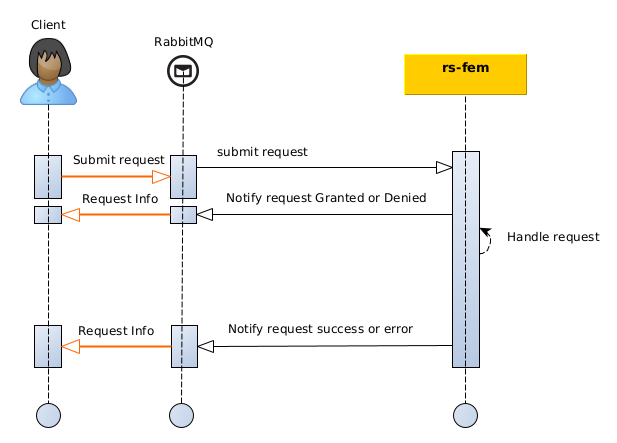Patch product
This section describes how to patch a product with the Feature manager or rs-fem service of REGARDS with
AMQP interfaces.
Introduction
To patch a product through AMQP API, you have to submit an existing product in GeoJson format with some additional information. These additional information allows you to:
- Choose method to handle product associated files.
- Recipient acknowledge. A patch request can also be used by a notification recipient to acknowledge product dissemination.
- Add meta information about the creation process.
To identify the feature you want to patch, Feature manager or rs-fem microservice will use the provided unique
identifier of the product the urn parameter.
Patch requests allow you to provide all or part of the product metadata to be updated. Only the metadata supplied will then be modified. Metadata not supplied will not be modified.
For the associated files, you can replace or append files using the amqp header request.file_update_mode.
The diagram below explains the global processing of a new Feature patch request by REGARDS system.
For a REGARDS client using message queuing, responses are sent for each change of your request status:
DENIED: Your request has been denied (possibly malformed request).GRANTED: Your request has been granted and will be processed soonERROR: Processing of your granted request finished in error status.SUCCESS: Processing of your granted request finished with success. Your SIP as been successfully ingest, AIP generated and associated files stored.

Requests and responses are linked with a correlation identifier requestId provided into patch requests and added in service responses.
When you submit a Feature patch request you have to ensure that the provided requestId is unique. Service will respond to your request with this identifier.
AMQP API
How to
The Regards AMQP API concept describe how AMQP interfaces must be handled to submit events or to subscribe to events.
Exchange
Patch requests have to be published to this REGARDS RabbitMQ exchange:
| Exchange | Virtual host |
|---|---|
regards.broadcast.fr.cnes.regards.modules.feature.dto.event.in.FeatureUpdateRequestEvent | regards.multitenant.manager |
Request content
Properties
| Parameter | Type | Description |
|---|---|---|
| priority | Integer | Standard RabbitMQ property to sort messages by priority order. |
| content_encoding | String | Standard RabbitMQ property for the encoding type of the message |
| content_type | String | Standard RabbitMQ property for the MIME Type of the message sent |
| delivery_mode | Integer | Standard RabbitMQ property for the delivery mode (persistent or not) |
Headers
| Header | Value |
|---|---|
| regards.tenant | The tenant or project to request. It must be an existing Regards tenant. |
| regards.request.id | String of max 36 characters long. You must ensure that this id is unique. |
| regards.request.date | ISO 8601 date (can be in the future to delay request processing). See How it works section for more information. |
| regards.request.owner | String of max 128 characters long |
| regards.request.file_update_mode | REPLACE or APPEND.See How it works section for more information. |
Use the request date parameter to delay the request processing if you need to by giving a date in the future. The given date, will the execution date of our request. If a past date is provided, request will be processed as soon as possible.
Body
| Property | Type |
|---|---|
| metadata | (See below) |
| feature | (look at description here) |
Properties to be updated will be merged with existing ones.
With metadata being described as this:
| Path | Type | Description | Optional |
|---|---|---|---|
| storages | Array | Target storages if there are files to store (may be an empty list!). See How it works section for more information. | false |
| storages[].pluginBusinessId | String | Storage plugin identifier (previously configured in Storage Management | false |
| storages[].targetTypes | Array | List of data object types accepted by this storage location | true |
| storages[].storePath | String | Directory in which to store the file | true |
| priority | String | HIGH, NORMAL, LOW.See How it works section for more information. | True |
| acknowledgedRecipient | String | Identifier of the recipient that has to be acknowledged. | true |
Example with only metadata update
With this example request you will update the feature identified with the given URN by overriding two parameters:
- properties_file_characterization.invalidation_date
- properties_file_characterization.valid
# Headers
regards.tenant=project1
regards.request.id=12345463-0f6b-4488-b58c-52af3f7e9563
regards.request.owner=owner
{
"metadata": {
"storages": [],
"priority": "NORMAL"
},
"feature": {
"urn": "URN:FEATURE:DATA:tenant:87fdda0e-27d1-494f-a1c0-c57f2f0810f7:V1",
"properties": {
"file_characterization": {
"invalidation_date": "2019-12-03T12:31:42.466Z",
"valid": false
}
}
}
}
Example with associated files update
With this example request you will update the feature identified with the given URN by:
- overriding two parameters
- Adding a file to the product
The file is added to an existing ones thanks to the regards.request.file_update_mode=APPEND header parameter.
rs-fem service can handle files update with different methods.
# Headers
regards.tenant=project1
regards.request.id=12345463-0f6b-4488-b58c-52af3f7e9563
regards.request.owner=owner
regards.request.date=2019-07-04T01:03:00
regards.request.file_update_mode=APPEND
{
"metadata": {
"storages": [],
"priority": "NORMAL"
},
"feature": {
"urn": "URN:FEATURE:DATA:tenant:87fdda0e-27d1-494f-a1c0-c57f2f0810f7:V1",
"files": [
{
"locations": [
{
"storage": "S3Server",
"url": "http://www.test.com/filename.xml"
}
],
"attributes": {
"dataType": "RAWDATA",
"mimeType": "application/xml",
"filename": "filename",
"filesize": 100,
"algorithm": "MD5",
"checksum": "checksum"
}
}
],
"properties": {
"file_characterization": {
"invalidation_date": "2019-12-03T12:31:42.466Z",
"valid": false
}
}
}
}
To find an example of how to store or reference files associated with the product, please refer to the create product guide examples.
Responses format
To learn how to subscribe to your request responses as described in the introduction diagram see Subscribe to responses.